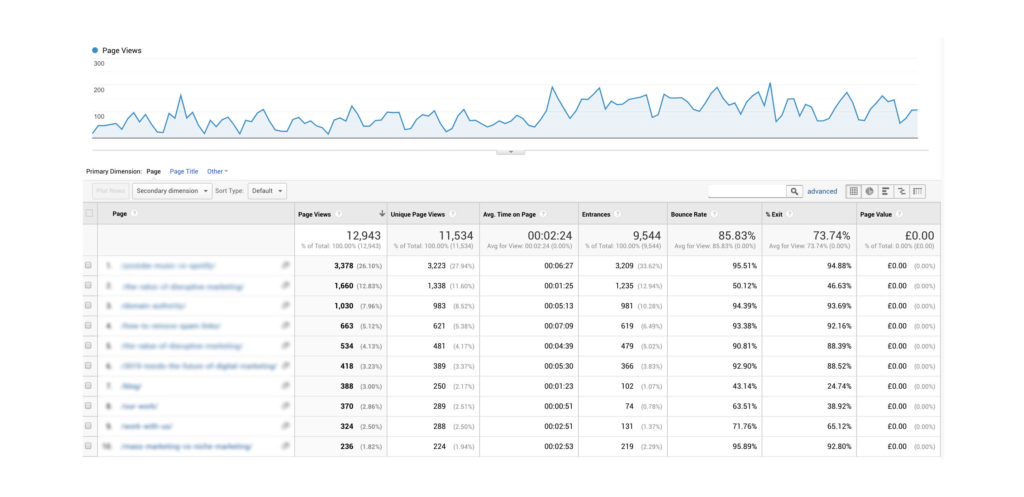A Guide to Repurposing Blog Content
22 May 2019
By Joseph Van Bergen
Repurposing can help give new life to some of your most successful content by exposing it to a new audience and revitalising the interest of previous users. Repurposing blog content isn’t lazy; if done well, it can be a shrewd bit of content marketing that speaks directly to your key demographic.
Occasionally, you’ll create a piece of content that just clicks – it reaches your target audience in unprecedented numbers, it gets shared along with positive feedback and, as a result, your business or brand experiences a boom of fresh interest.
It’s these pieces that you should be looking to repurpose. Pieces that have proven drawing power often have more to give and should be taken advantage of. Finding more interest for content that you know works is a lot easier than creating new content and, at times, can be more effective too.
How to identify your top-performing content
First, you need to find your top-performing content. You might have a piece that you are really passionate about and want to spread around again or expand upon, but if the content wasn’t well received the first time, there’s a good chance it won’t be again.
This doesn’t mean that this kind of content can’t be revisited, revived or rejuvenated, after all, the more quality content you can produce the better. However, to yield the best results from repurposing your blog content, you need to be using your top-performing content.
There are a number of ways you can find out which content this is:
1. Google Analytics
Google Analytics can show you which of your pages get the most views, so you know which of your topics are of the most interest to people. You can also see how long people chose to stay on a particular article, and whether they then went on to view more content.

In Google Analytics, you can view the engagement of your blog under the Behaviour > Site Content report.
You may not know exactly how people reacted to the content with this method, but a high level of traffic and lengthy average page view suggests that something about the blog topic or style has piqued people’s interest.
2. Google Rankings
Finding out which of your blogs or pages are highly ranked on Google is also useful for repurposing. If any of your articles are on the first page of results from a Google search for related keywords, then you know that this particular piece of content is easily discoverable, and therefore, a prime candidate for repurposing.
You can use Google Search Control to identify the search terms that people are entering your site with – and match these to your blogs.
3. Social Media Buzz
The amount of response or reaction your blog has received on social media is also a good barometer of its suitability for repurposing. If people have been talking about, sharing or generally responding positively online to your content, it is likely that repurposing this content will find a similarly enthusiastic audience, if it’s done well.
Using all three of these methods to identify your top-performing content will give you a great idea of which blogs you should be repurposing. If a piece of your content has had a large number of views, appears on the first results page of a Google search, and has had a positive reaction on social media, it will be perfect for repurposing.
For more information about understanding your data from Google Analytics, Google Search Control or your social channels, you can contact us and see how we can help.
Recycle, don’t republish
Repurposing blog content doesn’t mean simply finding a new website to post the same piece. Whilst you want to capitalise on what made the original blog successful, the key is to either continue the story in some way or help it find a new audience through a different medium, rather than just a different location.
Republishing the same piece on a different platform will only create duplicate content issues and make you seem lazy to your audience.
The trick to repurposing blog content is to find ways to expand upon the key themes presented in the original. If the original content was a case study, a follow-up on the subject’s progress since the first post can be very effective, to show their success was built on lasting foundations.
With informative or opinion pieces, has any new information come to light regarding the subject? Has the social or political landscape affected the views or predictions posted? Addressing issues like these is a perfect way to make your content topical and relevant without seeming contrived.
On a more aesthetic level, how does the content look? Is there anything you would change to the design, the arrangement or the formatting? The beauty of online content is that all these things can be rectified.
If the content is from a few years ago, the page may look dated, and this could prevent it from reaching new audiences. If the content is still relevant, giving the page a modern redesign could be an easy way to generate new interest. On reflection, is the medium of the piece still the most appropriate, or would the information be better received as a video or an infographic?
Related: Why Regular Blogging is Important for Your Business
Repurposing your blog content
With all of the above in mind, to really get the most out of your revitalised content, you need new platforms to share it on. There’s little point in spending time recycling your content if no one is going to see it.
Taking your content to a new platform can provide backlinks to your website that will improve your SEO. You will also have a second page addressing the topic that can be found through search engines, increasing the likelihood that yours will be the content users find first.
As successful as your site may be, your audience might have been the same for some time. While loyal customers are essential to the promotion of any brand or business, expansion depends on reaching new people and winning them over. Posting your content on a different platform places it in front of a new, pre-existing audience immediately.
Visual sites
There are many different platforms you can utilise, depending on your content. If you have repurposed your blog into a video, video streaming sites like YouTube and Vimeo are the obvious places to publish it.

Supplementing your blog with video content and publishing on sites like YouTube are a great way of enriching your content. A good example is the Whiteboard Friday blogs and videos from Moz.
While the audiences of these sites are less specialised, engaging visual content can appeal to people outside your usual demographic. Turning your old content into infographics or slide shows can also find a new home on sites like LinkedIn SlideShare.
Podcasts
Your content doesn’t have to be changed visually, however. If your content is engaging enough, it may make a good podcast, that people may find easier to engage with on-the-go.
This doesn’t just have to be an audibly-pleasing recital of the content, it could involve discussing the subjects of the content or a spirited debate with another party. This could also be a way to draw attention to the topics contained in other blogs you may be looking to repurpose.
Guest Blogs
Guest blogs can also be a great way to get more out of your top-performing content. A reputable site with a high domain authority that accepts guest blog submissions can be the perfect platform for your refreshed content.
These sites will already have their own dedicated following, much of which may not overlap with your own, but if the site’s subject areas are similar to your own, this new audience will likely be responsive to your content.
Question and Answer Websites
Your content may also find new life on forum sites like Quora, where users are looking for direct advice and solutions to their questions. While the whole repurposed blog may not be appropriate here, an informed and engaging response to the question with a link back to the full article could help establish your authority within the forum community.
eBooks
If you have plenty more to say on the subject of your blog, turning it into an eBook may be a worthwhile venture. The required length of an eBook is a lot more fluid than print publishing – you don’t need to write a novel to make a successful eBook. A successful eBook can lead to a subscriber list, and can also provide its own platform for future relevant content you may want to repurpose.
There will always be new platforms you can utilise to revitalise your content. Focus on updating, expanding upon, or changing the format of your content first, and then find the most suitable platform for the new content.
Soon, you’ll be reaping the benefits of quality engagement with a new audience without spending time on original content creation.
JVB.
For more advice on SEO-lead content creation, you are always welcome to get in touch with our team.